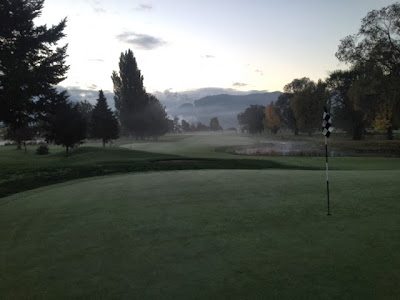 |
| 18th Hole, November 18th 2013 |
When I initially accepted the job of Interim Superintendent here at Kamloops Golf Club I was a little skeptical of my abilities to perform the job. Having graduated from turf school only 2 years prior and having been an Assistant for only one year, I was pretty green to say the least. What I did know is that I learned first hand from a few outstanding mentors and had the internal drive to succeed on the job. Whatever I didn't know I would figure things out as I went, (or at least try my best to). Jumping in with both feet seemed like a good way to learn quickly.
After a great winter, the course came out in great shape and we were off to the races. As the season started up I found myself dealing with all sorts of new responsibilities. From water licenses, to ordering fertilizer, calculating application rates, interviewing and hiring staff, troubleshooting irrigation pumps in the middle of the night and trying to keep a life outside of work. The only thing I could do was take it all in stride.
Managing people is something that I had done on a day to day basis as an Assistant, but now it was all day every day. I knew I would be a hands on Superintendent so leading by example was an easy way to motivate and see what was really going on out on the course. Part of the challenge of being a 26 year old boss is that some of your staff have been doing their job longer than you have been alive. Thankfully the staff on our Turf Care team were absolutely awesome and didn't miss a beat when I took the wheel. The long time staff were the least of my worries as they are able to get things done to a high level without much direction. The new staff require much more guidance, and after that it's sink or swim. We had a few great additions this year including our Intern from the Kwantlen Turf Management program, Sam Smith, who was a great asset for me personally. Taking over many spraying and irrigation duties as I was busy being a Superintendent.
When I started the year we set a few goals in terms of issues on the course. This included:
- Spraying fungicides preventatively to avoid another Take-All Patch outbreak on the greens
- Firming up the greens through heavier and more frequent sand topdressing and less frequent irrigation.
- Completing a light solid tine spring aeration to prove we are able to aerate with out doing damage.
- Growing a root-mass in the greens, capable of supporting the turf through the summer.
- Cultivating and re-seeding weak and bare fairway areas that we have had trouble with since the renovation.
 |
| Roots in July 2013 |
The fairway areas turned out fairly well. Some areas where we cultivated and added amendments grew in nicely, while other still struggled. We found that modifying the surround irrigation heads through adding more or changing nozzles made a great deal of difference. Part of the trouble is you can never tell overnight if the changes have helped, a great deal of patience is required for these things, something that many golfers do not seem to understand. Sometimes it just took leveling an irrigation head or pruning tree branches that were blocking the water from reaching its target. Some of these things that just get overlooked or left out when you have such a small staff to work with. Another thing that helped was using the GUR stakes and traffic signs to try and keep people (including our mowers) off the seeded areas. While some of these areas are still a work in progress, we will continue to work on them as we move forward.
 |
| 13th Hole, Sunshine open 2013 |
When all is said and done for this year, I feel we did a good job with what we had to work with. I am forever indebted to my senior staff, intern and and especially, mechanic, Quinton. Without Quinton there is no question my job would have been 100 times harder, and that would have been evident in the condition of the course this year. His knowledge and experience were very valuable tools for our turf care team this year, and I certainly owe him, big time.
 |
| 14th Hole, Sunshine Open 2013 |
We are already gearing up for next year's big tournament... The 2014 BC Women's Amateur Championship, July 7 - 11. We are looking forward to the Challenge and getting the course prepared between now and then. Bring on the Ladies!...Haha, see you all in 2014.










































.JPG)
